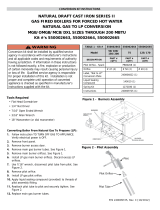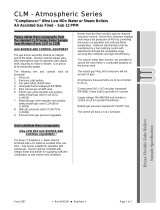
INSTALLATION INSTRUCTIONS
For Natural Gas to Propane and High Altitude Conversion Kit No: 1011789
This kit is designed to convert the NTP6, TNE, NDP6, TDE, NTPM, TNK, NCPM, TCK, NTVM,
VNK, *9MPV, *9MPT, *8MPV and *8MPT Series Furnaces equipped with Honeywell SV9540
Series gas valves and Honeywell Q3450 igniters from Natural Gas to Propane Gas.
* Denotes Brand (T, H or C)
This conversion kit shall be installed by aqualified service agency.
Please read these instructions completely before attempting
installation. Consult gas supplier and tables in National Fuel Gas
Code NFPA 54/ANSI Z223.1,1992 or latest edition. InCanada, the
National Standard CAN/CGA B149-1 and B149-2.
Parts List
Description Part# Qty
Burner Orifice #54 1011376 5
Pilot Orifice, LP (0.011) 1009136 1
Honeywell Cony. Kit #396021 1011828 1
Switch, Low Pressure 1008801 1
Fitting Asy. 1009775 1
Inlet Fitting 1147904 1
Wire Asy. 1009516 1
Label, Field Conversion 1009678 1
Label, LP Conversion 1011832 1
Label, Derate 2505235 1
Instructions 44106101507 1
Parts for High Altitude Conversion
Burner Orifice #55 (2000' - 7000')
Burner Orifice #56 (7000' - 8000')
Orifices required, but not included in kits.
1011354 as required
1011355 as required
This conversion kit shall be installed by a
qualified service technician in accordance with the
Manufacturer's instructions and all applicable
codes and requirements of the authority having
jurisdiction. The qualified service agency
performing this work assumes responsibility for
the proper conversion of this furnace with this kit.
Failure to follow these instructions exactly can
result in death, personal injury and/or property
damage.
AVERTISSMENT
Cet ensemble de conversion ne doit etre installe
que par le representant d'un organisme qualifie et
conformement aux instructions du fabricant et
tous les codes et exigences applicables de
I'autorite competente. L'organisme qualifie
quieffectue les travaux est responsable de la
conversion correcte de ce generateur d'air chaud
I'aide de cet ensemble. Quiconque ne respecte
pas a la lettre les instructions darts le present
manuel risque de declencher un incendie ou une
explosion entrainant des dommages materiels,
des lesions corporelles ou la perte de vies
humaines.
General Information
This kit is for conversion of furnaces equipped with Honeywell
SV9540 Series 2-stage gas valves certified for use with Natural
Gas (and so marked) to units functionally the same as the certified
furnace for use with Propane Gas. Before the furnace can be
operated with LP Gas, the LP low pressure must be installed (90+
models ONLY). A gas valve conversion kit must be installed and
main burner orifices and pilot burner orifice must be replaced with
orifices in this kit or with properly sized orifices for high altitude
ordered separately.
The orifices provided in this kit are stamped to indicate the size
(twist drill number) and are sized for commercially pure propane
gas ONLY. Do NOT use them with butane or a mixture of butane
and propane gas, or at elevations above 2000'. The parts list
specifies the size orifices supplied in the kit. Compare the size
marking on the orifices with the sizes as listed in the parts list.
Make sure you have the correct main burner orifices.
Extreme care is used to assure that this kit contains the proper
orifices. Oversized orifices could result in hazardous
conditions, especially if the venting is inadequate. For that
reason, we recommend that the installer check the size of the
orifice with a new twist drill of the correct size. This procedure
assures that the orifices provided are the correct size.
D Shut off gas supply to furnace at manual shut-off valve
before starting installation.
D Disconnect electric power supply to the furnace before
starting installation.
D Check for gas leaks after installation of kit and before
attempting to start furnace.
D Locate the LP Gas Conversion Label next to the furnace
rating plate.
D Fill out and attach the Field Conversion Label to the front
exterior of the furnace.
Gas Pressure
D Refer to the furnace rating plate for the approved gas input
ratings.
D Gas input to burners MUST NOT exceed the rated input
shown on rating plate.
D Do NOT allow minimum gas supply pressure to vary
downward. Doing so will decrease input to furnace. Refer
to Table 1 for gas supply and manifold pressures.
441 06 1015 07 (10/2003)









